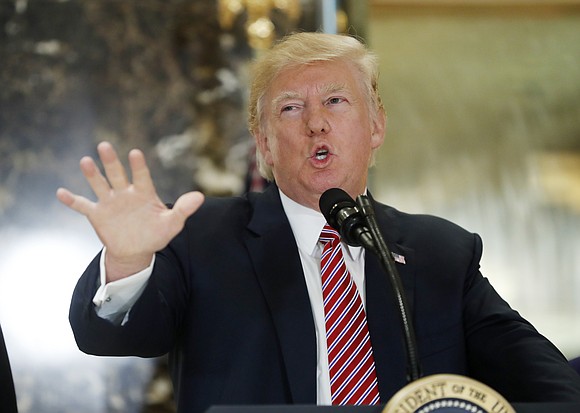Trump's Target Audience in Spreading Blame: His Base
CNN/Stylemagazine.com Newswire | 8/16/2017, 7:31 a.m.
Analysis by Jeremy Diamond, CNN
(CNN) -- President Donald Trump revealed Tuesday the driving force behind his initial response to the violent clashes that broke out Saturday in Charlottesville: his political base.
Trump's initial response to the violent protests sparked by a racist, white supremacist, neo-Nazi rally was to avoid condemning those groups by name and instead blame "many sides" for the violence. On Tuesday, he again blamed "both sides" and signaled he was standing up for those who oppose the removal of Confederate monuments from public squares -- making clear he was more concerned about not alienating his political base than exercising his moral responsibility as President.
"Not all of those people were neo-Nazis, believe me. Not all of those people were white supremacists, by any stretch. Those people were also there because they wanted to protest the taking down of a statue, Robert E. Lee," Trump said, emphasizing at several points during the impromptu news conference that the rally protesting the statue's planned removal was attended by non-white supremacists as well.
And then, as if channeling the views espoused by many Americans who flocked to his rallies during the presidential campaign by the thousands -- those Americans Trump could easily picture protesting the statue's removal without adhering to white supremacist ideology -- he added: "So this week it's Robert E. Lee. I noticed that Stonewall Jackson's coming down. I wonder, is it George Washington next week? And is it Thomas Jefferson the week after? ... You really do have to ask yourself, where does it stop?"
"You're changing history. You're changing culture," Trump said.
Trump's point -- which helps explain his restrained Saturday statement -- was that efforts to remove Confederate symbols around the country aren't just opposed by neo-Nazis and white supremacists, but by a much larger share of Americans who supported him in the presidential election. And Trump appears to have been wary of alienating that segment of his base -- declining on Saturday and Sunday to issue a more forceful statement until a heavy Republican backlash prompted him to offer a full-throated condemnation of white supremacist groups on Monday.
Activist campaigns to strip public squares of confederate symbols, charges sometimes led by leaders of the Black Lives Matter movement, who were regularly booed and disparaged by Trump supporters during the campaign, have sparked controversy throughout the South.
More than half of Americans viewed the Confederate flag as a symbol of Southern pride, according to a July 2015 CNN/ORC poll -- the most recent polling on this question.
In Louisiana, a hot spot in the debate over Confederate symbols, 73% of people surveyed said they opposed the removal of Confederate monuments, according to a 2016 Louisiana State University poll.
Still, Trump's remarks signaled a deep disconnect between the President and many Americans, who watched in horror as a rally organized by neo-Nazis and white supremacists turned violent and later as video of a car manned by an apparent white supremacist rammed into a crowd of counter-protesters, killing one.
Trump's comments Saturday, and his lengthier explanation and defense of those comments Tuesday, sent signals that the President was more concerned about not upsetting a segment of his base than he was about unifying the country.
Trump insisted Tuesday he wanted to "get the facts" before condemning neo-Nazis and white supremacists by name. But the explanation doesn't hold water as Trump has frequently side-stepped facts and has been quick to cry "terrorism" well before authorities have reached any conclusions.
The case Trump laid out Tuesday -- emphatically and repeatedly -- appeared pulled from the talking points of conservative and "alt-right" commentators who have also warned about a slippery slide toward "the eradication of history," as conservative commentator Laura Ingraham put it earlier Tuesday on "Fox & Friends," a program Trump routinely watches.
"This is not about racial healing. This is about the control of the narrative and a destruction of historical recognition," Ingraham said, before referring to leftist activists who have pushed for the removal of Confederate monuments. "How long before they show up at Monticello, where I spent three years in law school at Charlottesville in Virginia? How long before they show up at Mount Vernon?"
The President's chief strategist, Steve Bannon, also brings a deep understanding of Trump's base and their concerns. That's one of the reasons the President has so far refused to eject the former Breitbart chief amid mounting calls for the rabble-rousing populist who considers himself an "economic nationalist" to be pushed out. Bannon is a crucial voice inside the White House who can easily channel the President's base, just as he keeps track of the President's campaign trail promises on a wall in his West Wing office.
Bannon, sources said, communicated with the President via text on Saturday as he prepared to respond to the Charlottesville protests that turned violent.
Trump's statements this week in the aftermath of the Charlottesville incidents come as the President continues to face upside down favorability ratings, with just 36% of Americans approving of his job as President, according to the latest Gallup poll.
With his political capital already floundering, Trump knows he can't afford to lose any more support if he intends to make inroads in implementing his agenda.




